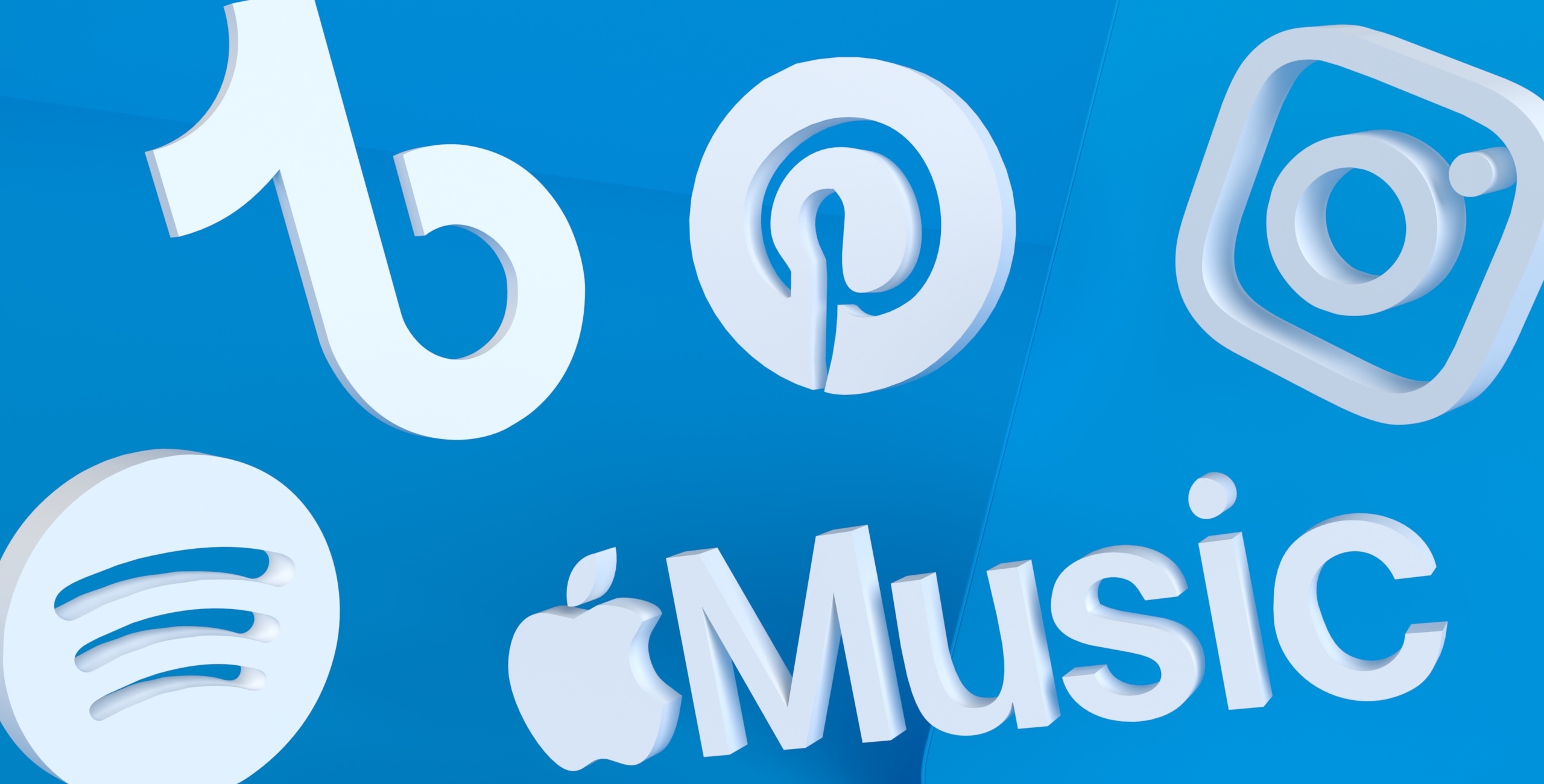Overview:
- The apps & social platforms industry ranks tenth in our Brand Intimacy COVID Study. To view our new study, click here.
- Spotify is the top-ranking apps & social platforms brand. To see Spotify’s brand profile, click here.
- During COVID, apps & social platforms brands have ranked higher than the industry average for the enhancement and ritual archetypes. To read our apps & social platforms industry page, click here.
Introduction
As businesses and their brands face unprecedented challenges in the face of the COVID pandemic, we are sharing our new insights on how brands can refocus, enhance, or optimize for the marketplace we are eager to see return.
This article is based on data and findings from our new Brand Intimacy COVID Study, conducted with 3,000 consumers in late summer 2020, revealing how leading brands have been affected by the pandemic.
Brand Intimacy Performance Today
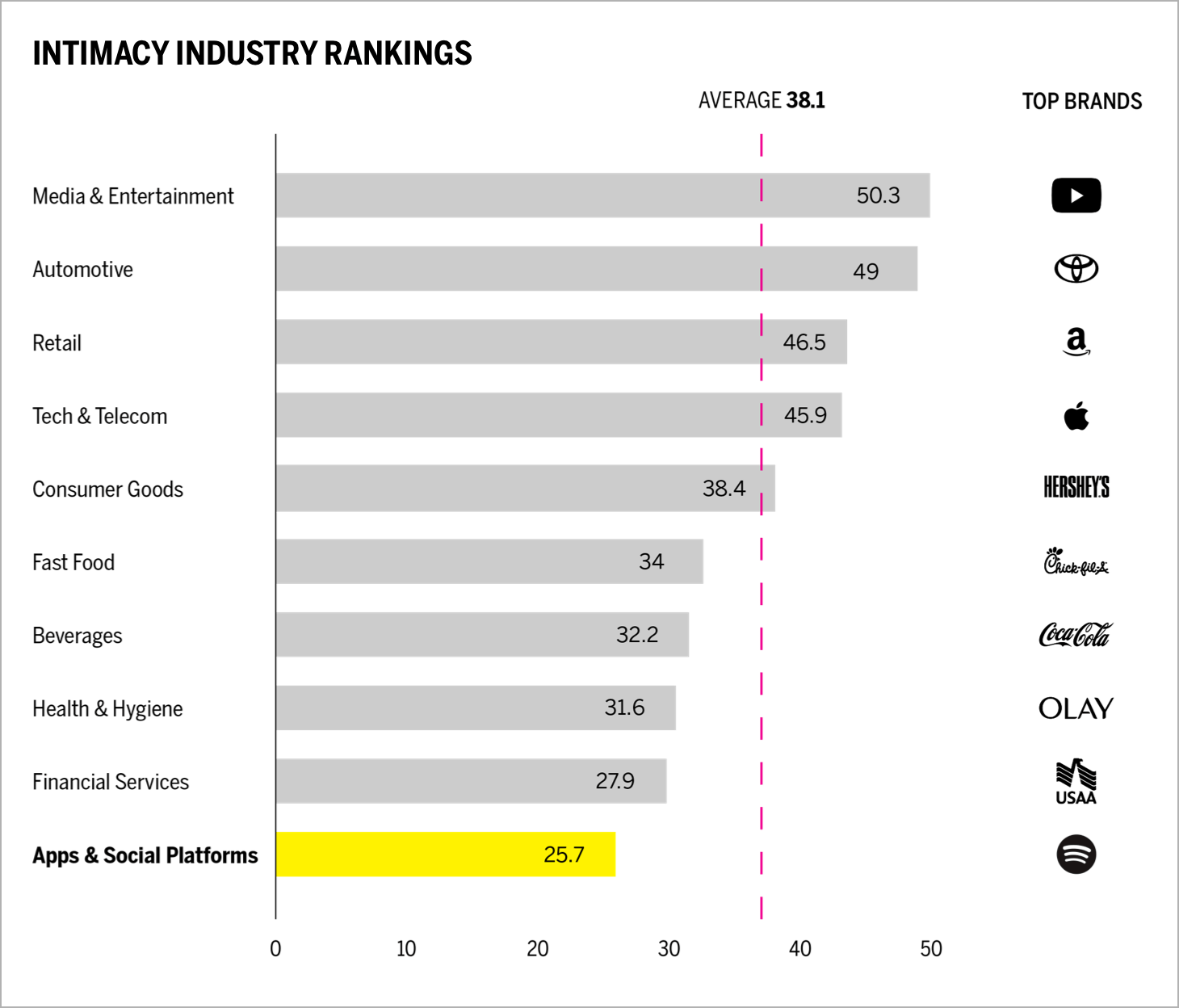
The apps & social platforms industry has an average Brand Intimacy Quotient of 25.1, well below the cross-industry average of 38.1. The category performs better with men than women and with younger consumers versus older ones.
Like most industries, the pandemic is clearly affecting business for apps & social platforms. Since February 29, 2020, Facebook has seen a 27 percent increase in use.1 Another source shows the frequency with which people game and use social apps is up by 20 percent.2 Spotify grew its active monthly users by 29 percent to reach 299 million in the second quarter.3 This is not surprising; we anticipated that, with a significant portion of the United States isolated at home, the need for escape, connection and enjoyment would increase.
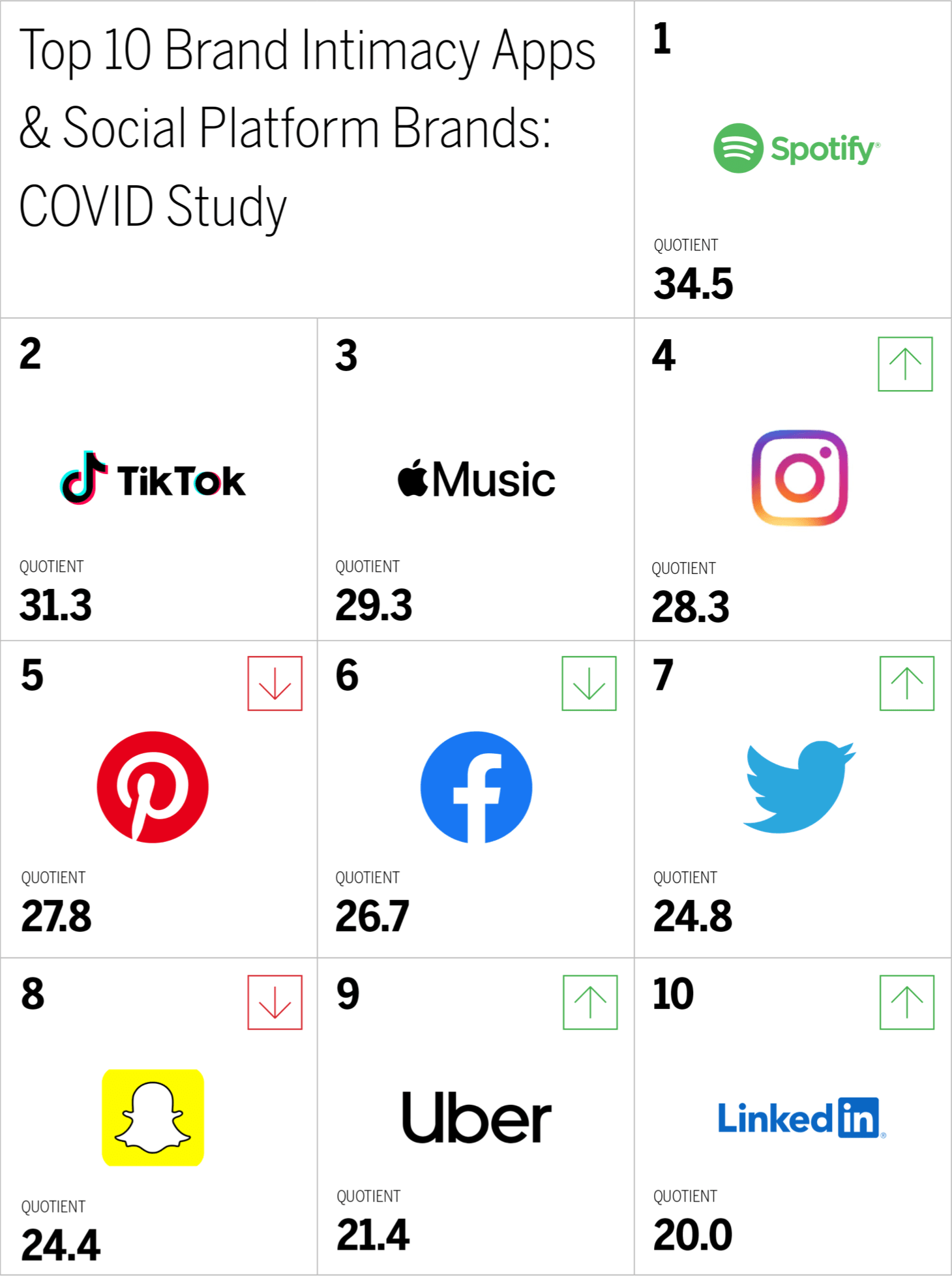
Spotify remains in the top position in the industry, and new entrant TikTok takes second place. Consumer preference for Instagram and Twitter has increased, whereas preference for Pinterest and Facebook has declined. Men ranked TikTok as their number one brand, whereas women preferred Spotify.

“Can’t live without” (a measure based on a ten-point scale that determines how essential a brand is to our lives) has increased during the pandemic by 14 percent, highlighting consumer reliance on apps & social platforms.

Daily usage has also risen during COVID, up 9 percent, demonstrating the increased need to communicate and connect while many were staying at home and isolated.
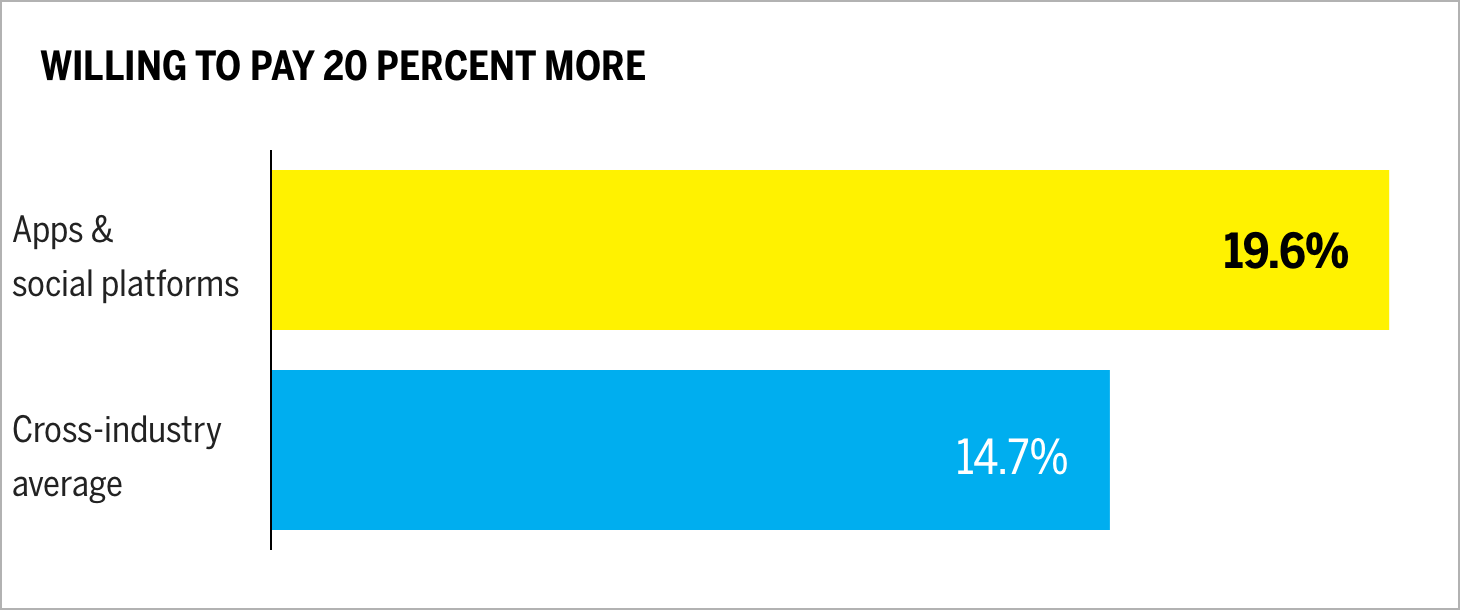
Spotify, the top-ranked apps & social platforms brand, has 18.7 percent of customers willing to pay 20 percent more for its products and services. This is 27 percent higher than the brand average in our study, highlighting that the more customers value their intimate brand relationships, the more they are willing to pay for the brands they use and love. The apps & social platforms industry also improved its overall average on consumer willingness to pay 20 percent more, rising 21 percent from our previous study.
When Brands Speak
In addition to our Brand Intimacy findings, which center on how consumers feel about their brand relationships, we are also looking at how brands have behaved and communicated during the pandemic. We have captured a language analysis from company websites and outbound social, focusing on six brands and encompassing 200,030 words.
This chart presents a comparison of how leading brands are communicating about COVID on their websites and social. We noted the appearances of key themes for each brand and the relative differences based on the other themes reviewed (e.g., Uber speaks 42 times more about safety policy compared to competitors).
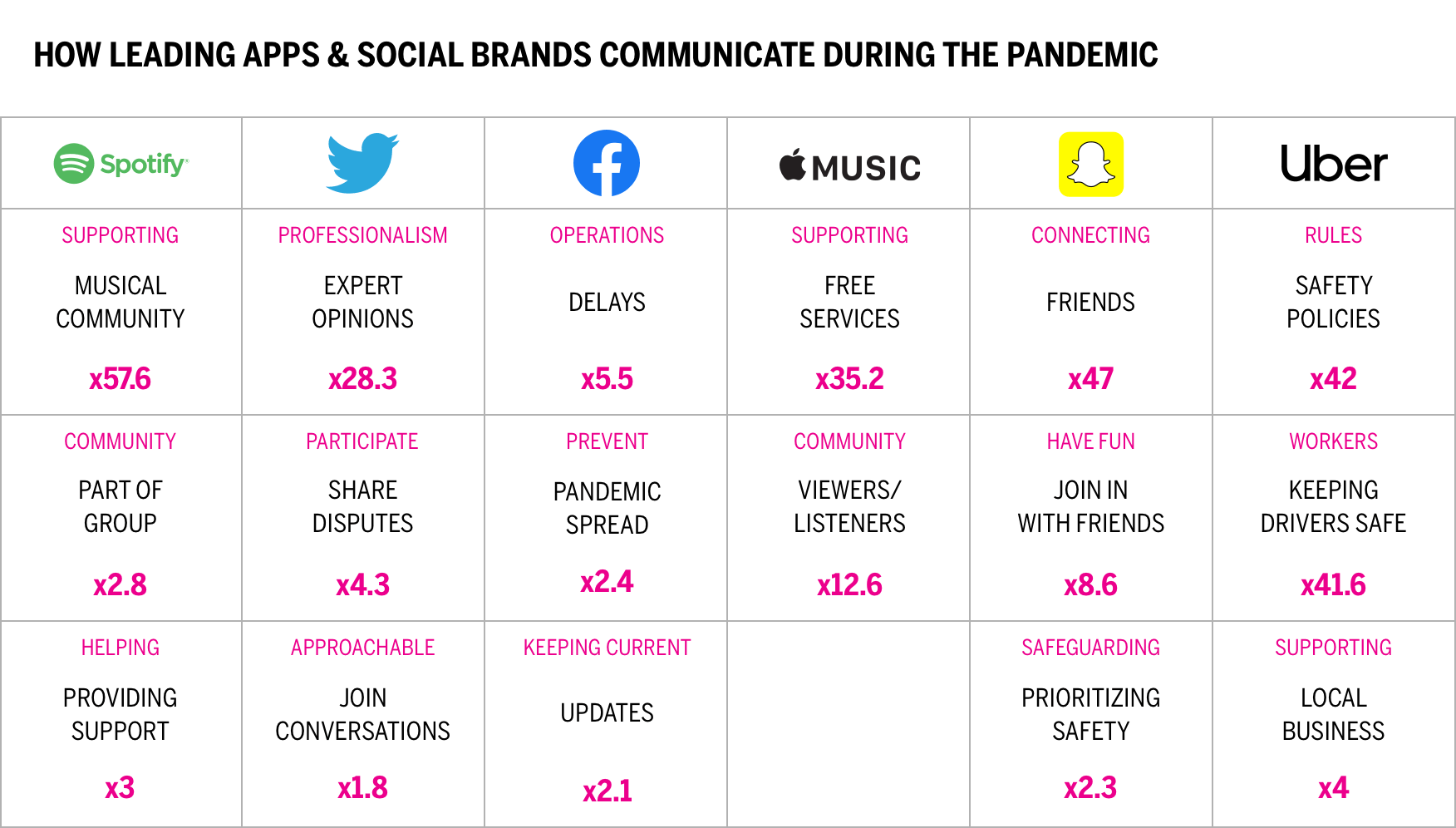
Each of the six brands reviewed has elected to take a slightly different approach to dealing with the pandemic in their communications. Spotify frequently talks about being part of, and supporting, a community. This is interpreted broadly, from artists to fans. The tone is straightforward and welcoming. Twitter is more academic. The platform focuses on highlighting expert opinions and appreciating professionalism. It invite people to join conversations and add input as well as sharing disputes or questionable tweets to enhance the experience. Facebook was the only brand to highlight operational delays and slowdowns related to the pandemic. It also emphasizes keeping people informed and encouraging individuals to do what they can to prevent the spread of COVID. Apple Music had less pandemic content than most of the other brands, highlight free services and speak to a community of listeners. Snapchat puts the focus on a safe way to connect with friends and the fun you can have together on the app. Uber is more informational, emphasizing its safety policies and expectations in vehicles, as well as initiatives and requirements to keep drivers safe. Uber also addresses helping local business by reducing fees on services.
There has been some pandemic-related advertising from brands over the past few months. Both Facebook and Uber focus on very emotional stories. Facebook highlighting our collective fear and struggles, whereas Uber thanks people for staying home, in an effort to keep everyone safe.
It is important to keep in mind that a brand’s tactics or communications are just a small signal of its intent and do not directly indicate how a brand creates greater intimacy.
Conclusion
Building and maintaining strong emotional connections with users is a core tenet of Brand Intimacy and a key principle for navigating these challenging times. The pandemic and the economic aftershocks will require brands to navigate in new and more carefully considered ways. Although we know frequency of use doesn’t correlate with building more intimacy with a brand, this situation creates a unique opportunity for social media brands to build stronger bonds with users.
The pandemic and the economic aftershocks will require brands to navigate in new and more carefully considered ways. For social media brands, we see a unique opportunity to leverage the collective spirit of fostering connections and the desire for positive change. Social media brands need to ensure they maintain the trust of users and find ways to celebrate the humanity that drives their communities. Elevating the triumphs and good of humanity may allow us to see past the divisive and negative sentiments that can pervade these platforms.
More than likes, clicks, and web traffic, brands that enable these communities to come together can build equity on fostering safe and meaningful connections that can blossom into a newer, better social media.
Read our detailed methodology here, and review the sources cited in this article here. Our Amazon best-selling book is available at all your favorite booksellers. Additionally, MBLM offers Custom Dashboards providing extensive data for brands included in its annual Brand Intimacy Study. To learn more about our Agency, Lab, and Platform, visit mblm.com.
